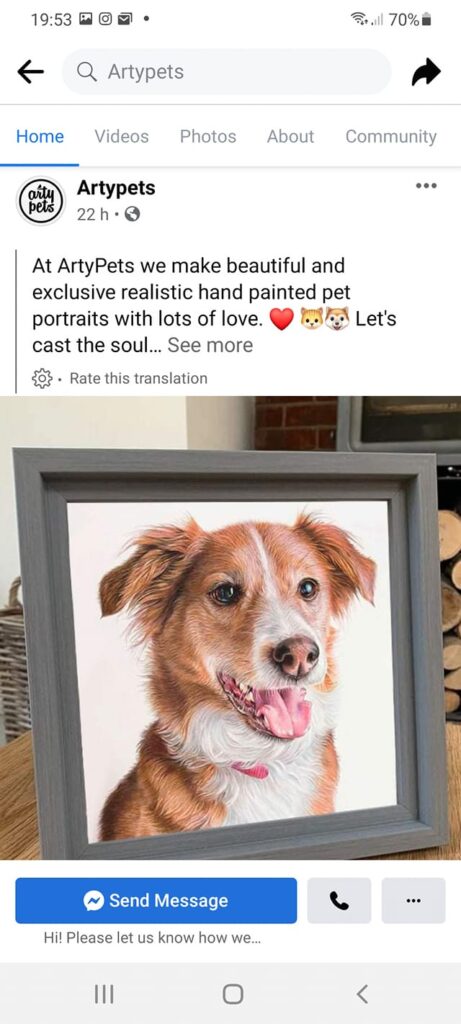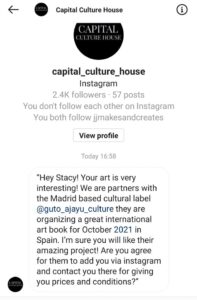Beware Of These 10 Common Art Scams On Social Media
Learn My Craft | 28th April 2023
Social media is an essential tool for artists to show off their work and reach a larger audience. However, with the popularity of social media, scams targeting artists have become more and more common.
From fake art competitions to phishing scams and artwork theft, there are lots of ways scammers are trying to exploit artists. As an artist, keeping yourself informed and up to date with the latest scams will help keep you safe.
In this article, we look at the top 10 art scams circulating on social media and give you our expert advice on how to avoid them.
In this article:
What Makes You Vulnerable To Scammers?
1. Payment Scams
2. Artwork Theft
3. Fake Art Contests
4. Phishing Scams
5. Fake Followers and Likes
6. Fraudulent Art Buyers
7. Payment Processing Scams
8. Fake Art Exhibitions
9. Contract Scams
10. Inappropriate Requests
How To Avoid Being Scammed
What Makes You Vulnerable To Scammers?
We are all vulnerable to scammers, it doesn’t make you stupid if you’ve fallen prey to a scam. Artists in particular have been targeted in recent years for a number of reasons.
Artists using social media to sell their art are asking buyers to send often considerable sums of money online. This requires a lot of trust, which is often formed due to the emotional connection artist and buyers have for the artwork. Scammers seek to exploit this trust and use it to their own advantage. As artists, we are usually open-minded and want to think the best of our community. This is wonderful but can create a blind spot if we aren’t vigilant.
Many artists are desperate for exposure and sales – it’s why they’re on social media in the first place. This makes it easy for scammers to dangle a carrot in front of you and offers you things that seem too good to be true. Sometimes there can be no red flags or warning signs at all that it’s a scammer rather than a genuine customer. Artists with limited business knowledge or experience fall prey to this all the time.
1. Payment Scams
Beware of people offering to buy your art and sending overpayment or fake checks. They may ask you to refund the excess amount or wire the money back to them, and once you do, the original payment will bounce, leaving you with a loss. Sometimes scammers offer to pay in Gift Cards, Western Union, or another money transfer service. Never accept and stick to your usual methods of accepting payment. Often these scams come from countries like Russia, the Philippines, Indonesia, Nigeria, India, and Romania. Be very cautious of accepting sales from these countries and if in doubt always refuse the sale and stick to your home market.
Here are some examples of possible messages you might receive:
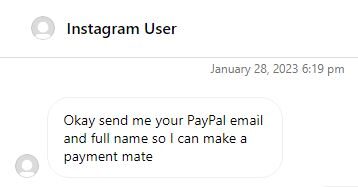
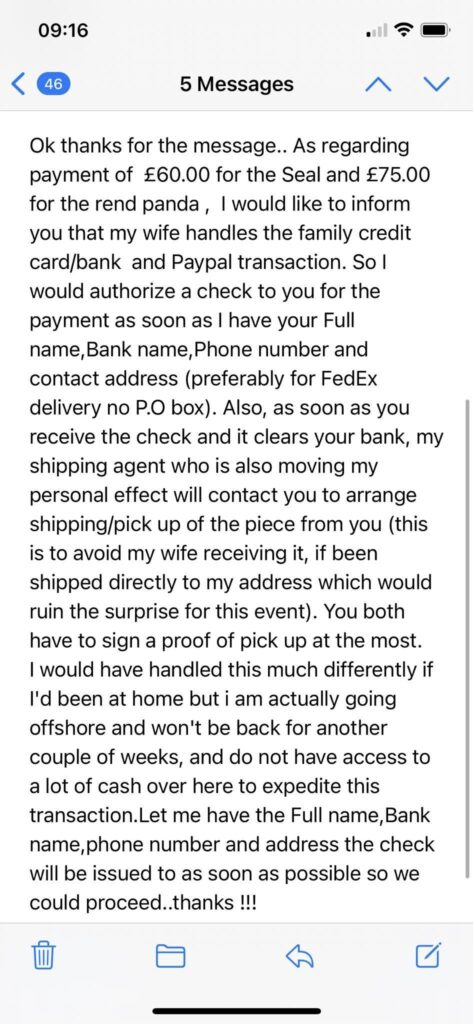
2. Artwork Theft
Some individuals or companies may steal your artwork from your social media page and use it for their own gain, without your permission. Look out for anyone who asks for high-resolution images of your work or who offers to sell your work without giving you proper credit or compensation. The scammer will use photographs of your work, even copy your entire website and use it to fraudulently mislead people into sending them money for work that is never done. Use Reverse Image Search to regularly search the web for your most popular artworks to stay ahead of the scammers.
Here is an example of an Instagram account scammer using other artists’ artwork as their own:
Here is an example of a facebook account using other artists’ work to sell commissions:
3. Fake Art Contests
Be cautious of contests, competitions, or surveys that require payment to enter. Also, be wary of those that promise significant rewards such as large amounts of money, art supplies, or exposure. Often these contests are bogus, designed to steal your artwork, money, or data with no real prizes given. Do your research and only enter reputable competitions. Fake Competition Scams are common on social media and in email marketing.
4. Phishing Scams
Some scammers may send you messages or emails that appear to be from legitimate companies or social media platforms, asking you to share your login credentials or other personal information. By doing this, they can steal your social media and email accounts or even your website and bank details. These scams often take the form of a message telling you you’ve been hacked and to follow a link to change your password. The link will be to a very convincing fake website, asking you to put in your account details. Whenever you get an email like this, or anything out of the blue asking for information spot and pause. Open a new browser and go to the company website yourself and log in. Never follow links from emails or social media messages, no matter how convincing they look. It’s important to stay savvy and Protect Yourself From Phishing as it’s a very common scam.
Here are some examples of this type of scam:
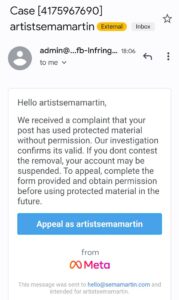

5. Fake Followers and Likes
Some services offer to boost your social media presence by selling you fake followers or likes. These are usually bots that are coded to randomly follow, like, and engage with accounts. The temptation to try it can be strong, especially when you are just starting out with few followers. However, it’s always a bad idea and a waste of money. The practice is ethically questionable and against the terms and conditions of every social media platform. Your account may be suspended or deleted if you get caught. More importantly, your reputation among real followers will be harmed. If you work with brands, be aware they can now verify how genuine your followers and engagement is using tools like Modash.io .
6. Fraudulent Art Buyers
Beware of buyers who request that you ship your artwork to them before receiving payment. Too often an artist will spend days or weeks creating an artwork, send it to the customer and never hear from them again, let alone receive the payment they were promised. Always take a deposit before starting any work and don’t ship the work until the full balance has been paid. For details on how to take payments online, see our guide Every Way To Take Payments From Your Art Customers.
Here is an example of how this type of scam can start:
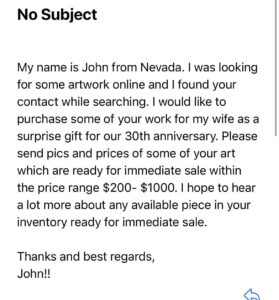
7. Payment Gateway Fraud
Your payment gateway is the system you use to take payments on a website, connecting merchant and customer. Common payment gateway frauds include card and identity theft, account hacking, and BIN attacks – where the scammer will use a bot to spam fake orders on your website using long lists of stolen or fraudulent credit card numbers. Common payment gateways like Stripe, PayPal, or World Pay have a certain layer of security built into them. Avoid using a lesser-known payment gateway as they can be bogus, full of vulnerabilities or charge extortionate fees. Stopping Gateway Fraud can be quite technical, so prevention is always better than cure.
8. Fake art exhibitions
Some scammers may offer to feature your artwork in an exhibition or gallery show in exchange for a fee. Be cautious of anyone who requires you to pay a fee upfront or who is especially pushy to get you to commit. Scammers use fake exhibitions to steal artwork and money from unsuspecting artists.
9. Contract Scams
Always read and understand any contracts or agreements before signing them. If a client comes to you with their own contract for you to sign, you need to read it very carefully and seek legal advice if you have any questions. Beware of contracts that contain hidden fees, unrealistic expectations, or that require you to sign over your rights to your artwork.
10. Inappropriate Requests
Beware of requests from individuals or companies that ask you to create artwork that is illegal, immoral, or offensive. When you are starting out it’s easy to feel like you should say yes to any work that comes your way, but resist. Having your name associated with inappropriate work will cause long-term damage to your reputation and could affect your ability to use social media platforms and professional services in the future.
How To Avoid Being Scammed
According to advice by Action Fraud, there are three basic rules to follow to avoid being scammed online:
“ 1. If something seems too good to be true, it probably is. 2. Don’t give out your personal information or login details to anyone without verifying their identity first. 3. Never click on links in unexpected emails, even if they appear legitimate.”
It makes sense to keep your security and privacy settings at the strongest possible level. Two-factor verification and strong passwords are essential. Change your passwords regularly (as often as 60 or 90 days is often advised), and avoid using the same login details for multiple sites.
Conduct regular searches for accounts using your business name, username, or identity. Use a Reverse Image Search to search for people illegitimately using your artwork.
Ultimately, trust your gut.
Gut feel and intuition is often the first warning sign we get when a scammer comes calling. If something feels wrong, or doesn’t sit right with you for any reason, say no until you’ve conducted further independent research. This includes clicking on links. Often they will contain wording designed to scare or excite you. Maintain a cool head and go through a basic verification process.
With a bit of knowledge, and some street savvy you can enjoy building your art business on social media and avoid falling victim to scammers.


